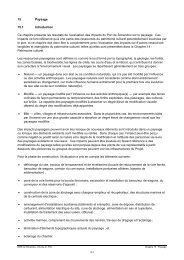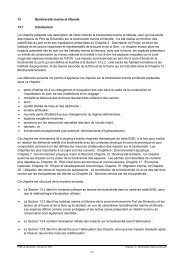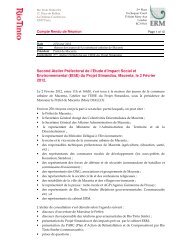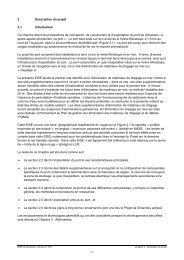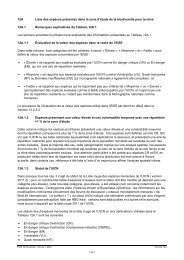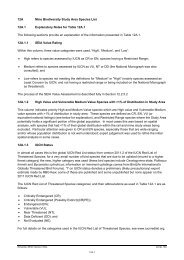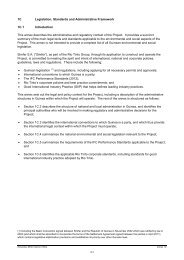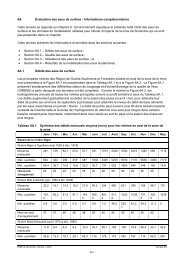Annex 14C: Cultural Context for West Africa and Guinea - Rio Tinto ...
Annex 14C: Cultural Context for West Africa and Guinea - Rio Tinto ...
Annex 14C: Cultural Context for West Africa and Guinea - Rio Tinto ...
You also want an ePaper? Increase the reach of your titles
YUMPU automatically turns print PDFs into web optimized ePapers that Google loves.
The country of <strong>Guinea</strong> <strong>and</strong> surrounding regions would have acted as an extremely important transportation<br />
route between the Medieval Empires <strong>and</strong> the gold fields in northern Akanl<strong>and</strong>, located in modern-day Ghana.<br />
Between the famous gold trading cities of Begho in Ghana <strong>and</strong> Jenne in Mali lies the famed trading city of<br />
Kong (in northern Ivory Coast, close to the <strong>Guinea</strong> border) (1) . <strong>Guinea</strong>’s proximity to major Medieval empires<br />
<strong>and</strong> the presence of known sites from the period point to a high probability <strong>for</strong> Medieval period sites<br />
throughout <strong>Guinea</strong>, including large-scale settlements <strong>and</strong> especially trading outposts.<br />
<strong>14C</strong>.2.2.2 Post-Medieval Period: AD 1591 – 1895<br />
This is the first period in which there is substantial in<strong>for</strong>mation on the cultural events <strong>and</strong> groups within<br />
<strong>Guinea</strong>, which is probably the result of both European record keeping <strong>and</strong> local oral tradition that still exists<br />
in living memory. Immediately following the collapse of the <strong>West</strong> <strong>Africa</strong>n Medieval empires in 1591, the <strong>West</strong><br />
<strong>Africa</strong>n region began a long period of cultural <strong>and</strong> economic decline. Initially Portuguese slavers, <strong>and</strong> later<br />
the French <strong>and</strong> British all battled <strong>for</strong> control over costal ports. Goree Isl<strong>and</strong> off the coast of Dakar is perhaps<br />
the best known slaving port, over which European powers were constantly fighting <strong>for</strong> control. A number of<br />
known cultural heritage sites of historical importance are located near the Isl<strong>and</strong> of Benty on the <strong>Guinea</strong>n<br />
southern coast. They are associated with the slave trade <strong>and</strong> include a slaver’s outpost <strong>and</strong> a jail dating<br />
between the 18 th <strong>and</strong> 19 th centuries. Other historical sites near Benty include: 1) the imposing tomb of<br />
Monsieur Maridet (the first French plantation owner on Benty); 2) the white colonial cemetery; 3) the remains<br />
of a slave point of embarkation; <strong>and</strong>, 4) an underground slave prison, among a few other sites of interest.<br />
While regional trade in <strong>West</strong> <strong>Africa</strong> continued, it never reached the scale that it achieved in earlier periods. A<br />
short-lived Fulani Empire overran large areas of <strong>West</strong> <strong>Africa</strong>, but didn’t fully take control or assert its<br />
influence very far outside of captured cities. Over the period from the 14 th to 17 th centuries AD, the Dyula,<br />
Malinke <strong>and</strong> other M<strong>and</strong>ingo-related groups from Mali gradually settled in <strong>Guinea</strong>. From the 15 th to the 18 th<br />
centuries, the Fulani (aka Peul) settled in the Fouta Djallon <strong>and</strong> established it as a base <strong>for</strong> their pastoral<br />
lifestyle. During the 18 th <strong>and</strong> 19 th centuries, the Koniake, Toma <strong>and</strong> Guerze ethnic groups in <strong>Guinea</strong><br />
organised a medium-sized trading confederacy in slaves, ivory, cloth, iron, arms, <strong>and</strong> kola nuts. This<br />
economic activity largely came to an end by 1900, when the French established a presence in the <strong>Guinea</strong><br />
<strong>for</strong>est regions.<br />
Perhaps one of the more interesting historical figures during this time period was that of Samoury Touré,<br />
founder <strong>and</strong> ruler of the short-lived Wassoulou Empire (1878-1898). He is known <strong>for</strong> resisting the French<br />
penetration until his capture in 1882 (2) . Touré had an important base in the Project area town of Kérouané<br />
where there are historical sites associated with him. As of 2006 one of his descendants still lived in the<br />
town (3) .<br />
It is likely that there will be a Project Area contains a high number of habitation sites from this time period in<br />
<strong>Guinea</strong>, although probably not as many as from the earlier Medieval Period, since the practice of slaving<br />
may have reduced the population of the entire <strong>West</strong> <strong>Africa</strong> region by as much as one half.<br />
<strong>14C</strong>.2.2.3 Colonial Period: AD 1895 – 1958<br />
The post of Governor General of French <strong>West</strong> <strong>Africa</strong> was created in 1885 in Saint-Louis, Senegal. After<br />
finally defeating Samoury Touré in 1898, the French exp<strong>and</strong>ed their influence to control over <strong>Guinea</strong>.<br />
Although plantations were set up along the coast of <strong>Guinea</strong>, the French never gained full control over the<br />
interior <strong>for</strong>est regions. The remnants of these plantations can still be seen along the coast. Benty Isl<strong>and</strong> on<br />
the <strong>Guinea</strong>n south coast also has a colonial past with three docks built by the French. French colonialists<br />
also operated a number of plantations that produced fruit <strong>for</strong> export out of Benty.<br />
The port area of the Project Area in particular may have a higher potential <strong>for</strong> archaeological remains from<br />
the Colonial period because of the importance of sea trade during this period. If any of these historical<br />
structures remain in the port area, they would be expected to be above-ground <strong>and</strong> thus fairly easy to<br />
(1) T. Diabete, 'La region de Kong apres les fouilles archeologiques' (Paris thesis, I979)<br />
(2) Gann, L.H. <strong>and</strong> Duigan, Peter, Editors: Colonialism in <strong>Africa</strong>, 1870–1960, Vol. 1: The History <strong>and</strong> Politics of Colonialism 1870-1914.<br />
(1969) Cambridge University Press, Cambridge, UK<br />
(3) Etude de Caractéristique Sociale – Kérouané ville (2006) Synergy<br />
Sim<strong>and</strong>ou SEIA Volume III Port <strong>Annex</strong> <strong>14C</strong><br />
<strong>14C</strong>-6



